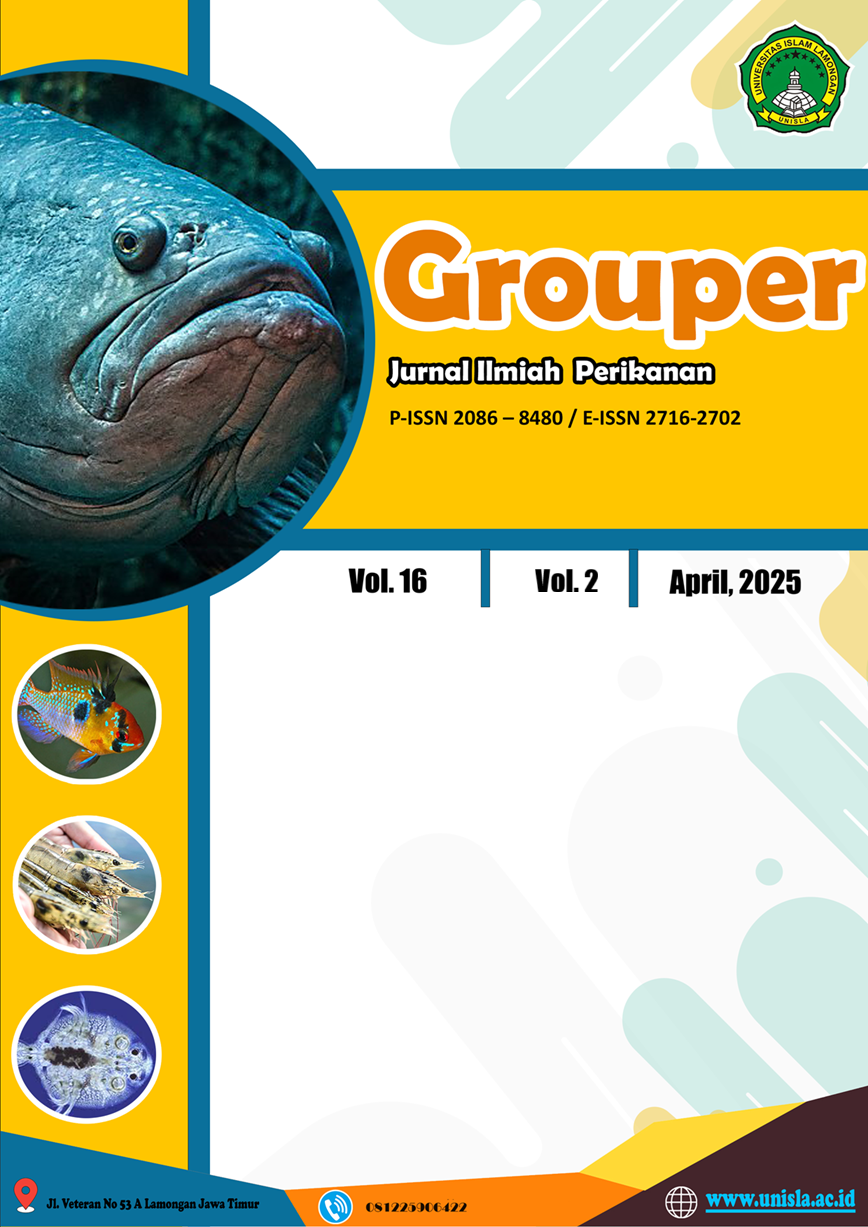Green Synthesis, Characterization, and Antimicrobial Activity of Silver Nanoparticles Derived from Sargassum sp. (Ag-SE)
DOI:
https://doi.org/10.30736/grouper.v16i2.334Keywords:
AgNP, Sargassum sp., antimicrobialAbstract
The growing threat of antibiotic-resistant bacteria has led to a search for alternative antimicrobial agents, including nanotechnology. This study successfully synthesized silver nanoparticles (AgNPs) using aqueous extracts of Sargassum sp., a brown macroalgae species rich in bioactive compounds. The formation of the AgNPs was indicated by a visible color change from pale yellow to brown and was further confirmed by UV–Vis spectroscopy. This spectroscopy showed characteristic surface plasmon resonance peaks between 400 and 450 nm across concentrations ranging from 1 to 4 mM. Fourier-transform infrared (FT-IR) analysis revealed functional groups, such as hydroxyl (3888 cm⁻¹), carbonyl (around 3500 cm⁻¹), and aromatic C=C bonds (1635 cm⁻¹), which suggest a role in reducing and stabilizing the nanoparticles. We evaluated the antibacterial activity of the AgNPs against Escherichia coli, and Staphylococcus aureus using the disc diffusion method. At a concentration of 3 mM, the AgNPs inhibited E. coli with a maximum zone of inhibition of 3.90 mm and followed by S. aureus (3.35 mm). Although the inhibition zones were relatively narrow (<2 mm), the results demonstrate the AgNPs' selective antibacterial potential. The antibacterial mechanism likely involves membrane disruption, oxidative stress via reactive oxygen species (ROS) generation, and Ag⁺ ion release. These findings highlight Sargassum sp. as an eco-friendly and effective source for the green synthesis of AgNPs with promising applications in antimicrobial therapies.
Downloads
References
Ahmad, S. A., Das, S. S., Khatoon, A., Ansari, M. T., Afzal, M., Hasnain, M. S., & Nayak, A. K. (2020). Bactericidal activity of silver nanoparticles: A mechanistic review. Materials science for energy technologies, 3, 756-769.
Arroyo, G. V., Madrid, A. T., Gavilanes, A. F., Naranjo, B., Debut, A., Arias, M. T., & Angulo, Y. (2020). Green synthesis of silver nanoparticles for application in cosmetics. Journal of environmental science and health, part A, 55(11), 1304-1320.
Gong, X. Jadhav, N. D. Lonikar, V. V. Kulkarni, A. N. Zhang, H. Sankapal, B. R. Ren, J. Xu, B, B. Pathan, H, M. Ma, Y. Lin, Z. Witherspoon, E. Wang, Z. & Guo, Z. (2023). An overview of green synthesized silver nanoparticles towards bioactive antibacterial, antimicrobial and antifungal applications. Advances in Colloid and Interface Science, 323(1): 1 - 23.
González-Fuentes, F. J., Molina, G. A., Silva, R., López-Miranda, J. L., Esparza, R., Hernandez-Martinez, A. R., & Estevez, M. (2020). Developing a CNT-SPE Sensing Platform Based on Green Synthesized AuNPs, Using Sargassum sp. Sensors, 20(21), 6108.
Gul, A. R. Shaheen, F. Rafique, R. Bal, J. Waseem, S., & Park, T. J. (2021). Grass-mediated biogenic synthesis of silver nanoparticles and their drug delivery evaluation: A biocompatible anti-cancer therapy. Chemical Engineering Journal, 407(1): 1-16.
López-Miranda, J. L., Esparza, R., González-Reyna, M. A., España-Sánchez, B. L., Hernandez-Martinez, A. R., Silva, R., & Estévez, M. (2021). Sargassum influx on the Mexican Coast: A source for synthesizing silver nanoparticles with catalytic and antibacterial properties. Applied Sciences, 11(10), 4638.
Mohanta, Y. K., Biswas, K., Rauta, P. R., Mishra, A. K., De, D., Hashem, A., Al-Arjani, A.B.F. Alqarawi, A.A., Abd-Allah, E.F., Mohanta, S., & Mohanta, T. K. (2021). Development of graphene oxide nanosheets as potential biomaterials in cancer therapeutics: An in-vitro study against breast cancer cell line. Journal of Inorganic and Organometallic Polymers and Materials, 31(11), 4236-4249.
Ponnusamy, A. SR, R. R. Rajan, R. & Ashraf, F. (2024). Chitosan silver nanoparticle inspired seaweed (Gracilaria crassa) biodegradable films for seafood packaging. Algal Research, 78(1): 1-12.
Premkumar, J., Sudhakar, T., Dhakal, A., Shrestha, J. B., Krishnakumar, S., & Balashanmugam, P. (2018). Synthesis of silver nanoparticles (AgNPs) from cinnamon against bacterial pathogens. Biocatalysis and agricultural biotechnology, 15, 311-316. https://doi.org/10.1016/j.bcab.2018.06.005
Rozilah, A. Jaafar, C. A. Sapuan, S. M. Zainol, I. & Ilyas, R. A. (2020). The effects of silver nanoparticles compositions on the mechanical, physiochemical, Laantibacterial, and morphology properties of sugar palm starch biocomposites for antibacterial coating. Polymers, 12(11): 1-21.
Shao, Y., Wu, C., Wu, T., Yuan, C., Chen, S., Ding, T., Ye, X., & Hu, Y. (2018). Green synthesis of sodium alginate-silver nanoparticles and their antibacterial activity. International journal of biological macromolecules, 111, 1281-1292.
Sheng, Y., Narayanan, M., Basha, S., Elfasakhany, A., Brindhadevi, K., Xia, C., & Pugazhendhi, A. (2022). In vitro and in vivo efficacy of green synthesized AgNPs against Gram negative and Gram positive bacterial pathogens. Process Biochemistry, 112, 241-247.
Soo, J. Z. Chai, L. C. Ang, B. C. & Ong, B. H. (2020). Enhancing the antibacterial performance of titanium dioxide nanofibers by coating with silver nanoparticles. ACS Applied Nano Materials, 3(6): 1-36.
Downloads
Published
How to Cite
Issue
Section
License
Copyright (c) 2025 Adellia Ramadhani Putri Pratiwi, Heru Pramono, Mochammad Amin Alamsjah

This work is licensed under a Creative Commons Attribution-NonCommercial-ShareAlike 4.0 International License.







.jpg)
1.png)



